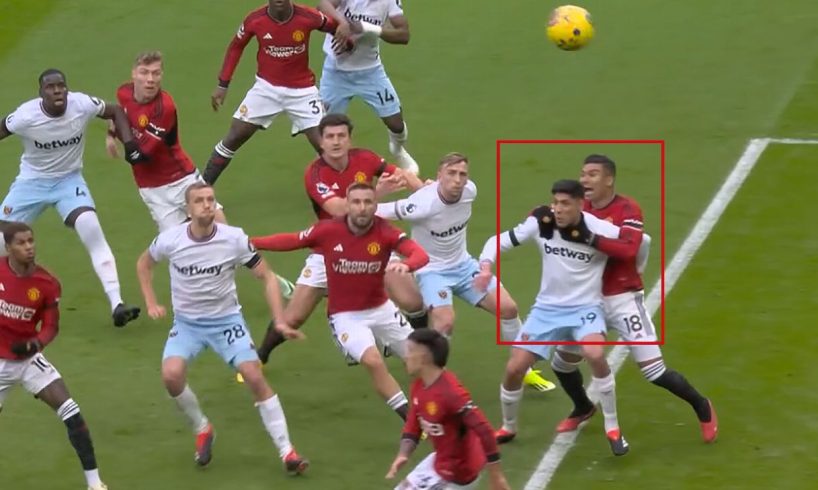
Video Assistant Referee causes controversy every week in the Premier League, but how are decisions made, and are they correct?
After each weekend we take a look at the major incidents to examine and explain the process both in terms of VAR protocol and the Laws of the Game.
– How VAR decisions have affected every Prem club in 2023-24
– VAR in the Premier League: Ultimate guide
In this week’s VAR Review: Should West Ham United have been awarded a penalty against Manchester United? And what about the spot kick Wolverhampton Wanderers were given against the Red Devils on Thursday? Plus, all the incidents from Arsenal’s win over Liverpool, and Everton’s dramatic home draw with Tottenham Hotspur.
Possible penalty: Challenge by Casemiro on Álvarez
What happened: James Ward-Prowse delivered a corner into the area in the 11th minute, with Tomás Soucek seeing his deflected header saved by André Onana. But was there a foul on Edson Álvarez as ball came over?
VAR decision: No penalty.
VAR review: It brings us back to the discussion about when holding is an offence, when it’s being carried out by both players, or if it’s inconsequential to a passage of play. All this has to be taken into account when the VAR is deciding whether there’s been a clear and obvious error.
Editor’s Picks
2 Related
There’s all kinds of holding and grappling off the ball on every set piece. It can be argued that this should be penalised more often to discourage players from trying it, yet the VAR will usually get involved only if the holding has a material impact.
While the holding could be considered to have restricted Álvarez’s ability to properly deflect Soucek’s header into the goal, he too has an arm around the Manchester United player and is backing in, so there would need to be more than a simple holding offence from Casemiro; the only real consideration for the VAR would be the position of Casemiro’s arms towards Álvarez’s neck.
It looks far worse on still images that in real time, and it’s unlikely to have sufficient impact for a VAR review in the Premier League.
Also, while the ball touched Casemiro’s arm to cause the deflection, this couldn’t be considered a handball offence as it wasn’t creating a barrier to goal that would by itself have stopped the path of the ball.
Casemiro holds on to Edson Álvarez as a corner is delivered into the penalty area. BBC
Possible penalty overturn: Challenge by Casemiro on Neto
What happened: A game from Thursday night, and the end of the midweek round of Premier League games. In the 68th minute, Pedro Neto attempted to check inside and went down after a challenge from Casemiro. Referee Jarred Gillett pointed to the penalty spot and the decision was checked by the VAR, Paul Tierney.
VAR decision: Penalty stands, scored by Pablo Sarabia.
VAR review: Casemiro dangles out a leg, and contact is minimal, but Neto uses it and goes to ground theatrically. Football would much rather the VAR intervenes in situations like this, when a player is clearly trying to influence an official by exaggerating contact. The VAR wouldn’t give a spot kick for this, so it feels wrong it would be allowed to stand.
It shows how a referee has to assess incidents differently — whether they are on the pitch or in the VAR hub. Tierney was the referee for the Liverpool vs. Chelsea game 24 hours earlier, when he had turned down penalty appeals from the away side. Then he sees a soft penalty awarded when he’s the VAR, but doesn’t intervene because the threshold for an intervention hasn’t been reached.
Earlier this season, Howard Webb, the chief refereeing officer, said he wanted the VAR to step in and stop soft penalties. That came after, coincidentally, Wolves were on the wrong end of decisions against Newcastle United and Sheffield United — which the Independent Key Match Incidents Panel said should have been cancelled.
Perhaps in this case there was more of an obvious challenge than in the two decisions that went against Wolves, but finding the right balance on clear and obvious interventions is still problematic, and the VAR is loathe to intervene if they can find evidence of contact.
Pedro Neto goes down easily after slight contact from the boot of Casemiro. NBC
Possible disallowed goal: Offside against Saka
What happened: Arsenal took the lead in the 14th minute, but there was a check for offside against the goal scorer, Bukayo Saka (watch here.)
VAR decision: Goal stands.
VAR review: Saka was in front of the ball but behind the last defender, Ibrahima Konaté.
Possible disallowed goal: Handball by Gabriel
What happened: Liverpool equalised just before half-time when Diogo Jota helped the ball on and it went in off Gabriel. But can a goal be scored off an arm? (watch here)
VAR decision: Goal stands.
The ball comes off the arm of Gabriel, leading to an own goal. BBC
VAR review: While an attacking player cannot score if the ball hits his hand immediately before going into the goal, this doesn’t apply to own goals. So, a defender can accidently “score” with his arm or hand.
If the ball hadn’t gone into the goal, there would have been a strong case for a handball penalty as Gabriel’s arm appears to move toward the ball.
Possible red card: Konate challenge on Havertz
What happened: There’s a debate to be had over whether there really was a foul by Konate on Kai Havertz, but that decision is not within the purview of the VAR, David Coote. However, was there a case for a red card for denying an obvious goal-scoring opportunity (DOGSO)? (watch here)
VAR decision: No red card.
There was no DOGSO situation for Ibrahima Konaté’s challenge on Kai Havertz. BBC
VAR review: Among the elements for a DOGSO red card are the attacking player being in possession of the ball, as well as the distance from goal. As two players were jostling for a bouncing ball, and Havertz isn’t yet in control, it’s not certain he would be able to take it on and have a strong chance at scoring, especially as Virgil van Dijk is coming back to cover.
If the VAR had sent the referee to the monitor for the red card, Taylor would in fact have retained the right not only to reject the red-card review for DOGSO, but even to change his own decision from a free kick and a yellow card. Once a referee has been sent to the screen, they are in charge of any final outcome, regardless of how rare it is for them to go against the VAR.
Konate would go on to receive a second yellow card when he blocked Havertz on a break, raising his arms to stop the forward’s run.
Possible penalty: Mac Allister challenge on Havertz
What happened: Havertz raced into the area in the 63rd minute and went down in a challenge with Alexis Mac Allister. Referee Taylor had the perfect view behind the players and immediately signalled that play should continue. Alisson Becker made a long clearance from the loose ball.
VAR decision: No penalty.
No penalty was awarded after Alexis Mac Allister clashed with Kai Havertz. BBC
VAR review: It’s unclear from the replays whether there was really any kind of challenge made, with the coming together a result of Havertz placing his right foot across Mac Allister to try to keep possession of the ball.
Not enough in this for the VAR to consider a spot kick.
Possible disallowed goal: Challenge by Harrison on Vicario
What happened: Everton equalised for the first time in the 30th minute. A corner came in from the right, it was headed back across goal by James Tarkowski, then Dominic Calvert-Lewin’s header went in off Jack Harrison. Referee Michael Oliver awarded the goal, but was there a foul on goalkeeper Guglielmo Vicario? The VAR, Stuart Attwell, began a check.
VAR decision: Goal stands.
VAR review: We discussed in last week’s VAR Review how challenges on the goalkeeper have been left to the on-field decision for the most part this season — save for one overturn in Aston Villa’s 1-1 draw with Sheffield United, when Jacob Ramsey was holding on to the arm of Wes Foderingham as a cross was played over.
Since then, there have been a series of incidents involving minor contact with a keeper inside the 6-yard box. Indeed, Vicario himself conceded a goal against Manchester City in the FA Cup last month when Rúben Dias was applying a similar amount of limited pressure before Nathan Aké scored the winner.
Jack Harrison puts pressure on Tottenham goalkeeper Guglielmo Vicario. BBC
Whether a goalkeeper has been impacted will always be a judgement call — Oliver did give free kicks in the Tottenham Hotspur player’s favour when he felt the line had been crossed. It seems that Vicario may well be the focus of attention for opposition players on set pieces going forward, something that Spurs boss Ange Postecoglou will have to combat.
Nothing has changed with the interpretation in the Premier League; perhaps it’s more a case of attackers seeing what they can get away with more often.
Tottenham goalkeeper Guglielmo Vicario was also put under pressure by Manchester City’s Rúben Dias. Charlotte Wilson/Offside/Offside via Getty Images
There can be no offside against Harrison because when Calvert-Lewin heads it, both Vicario and a Spurs defender are inside the goal, and the law states those players are considered to be on the goal-line.
Possible penalty: Dragusin foul on Beto
What happened: A cross was delivered into the area in the 90th minute, with Beto going to ground under a challenge from Radu Dragusin. The Everton player wanted a penalty, but the referee waved play on.
VAR decision: No penalty.
Radu Dragusin clashes with Beto inside the area. BBC
VAR review: While Dragusin is holding Beto’s shirt for a short time, this isn’t going to be enough to be seen as a clear and obvious error. Beto goes to ground too easily for a VAR intervention.
Possible disallowed goal: Offside against Coleman
What happened: Everton grabbed an equaliser in the fourth minute of added time when Jarrad Branthwaite headed home from close range after a free kick delivered into the area by James Garner. But was there an offside in the move?
VAR decision: Goal stands.
VAR review: There was no issue over an offside position for Branthwaite, who ran from behind the Spurs defence to score. This decision was about the role of Seamus Coleman, who was close to defender Cristian Romero as he attempted to head the free kick away from danger.
If Coleman had been in front of the last defender, the goal would have been ruled out for challenging an opponent from an offside position.
If Branthwaite had been in fact been offside it’s unlikely the VAR would consider the flicked header from Romero to be a controlled “deliberate play” to reset the phase, so the goal would most likely have been ruled out.
Possible penalty: Position of foul by Burn on Ogbene
What happened: Chiedozie Ogbene burst past Dan Burn in the 55th minute, with the Newcastle United defender holding onto the shoulder of the midfielder. Referee Thomas Bramall awarded a free kick just outside the area after the assistant had flagged, and the VAR checked for a possible penalty.
VAR decision: Penalty, scored on a retake by Carlton Morris.
VAR review: When a player is fouled by an opponent making a tackle, it’s the point of contact on the offence that determines where it took place. Yet when it comes to holding, if that starts outside the box but continues into it, then a penalty is awarded.
Once the VAR, Michael Salisbury, was able to confirm on the replays that Burn still had his arm on Ogbene’s shoulder once the penalty-area line had been reached, he has to intervene to award the spot kick.
The referee didn’t need to go to the monitor to review it himself as it was a factual decision based on position, rather than a subjective consideration on the foul.
The penalty had to be retaken because the referee had his back to the goal sorting out the position of the other players on the edge of the area.
Dan Burn is still holding Chiedozie Ogbene after the players enter the area. BBC
Possible disallowed goal: Challenge by Miley on Barkley
What happened: Newcastle equalised in the 73rd minute when Harvey Barnes scored from outside the area, but was there a foul immediately before the goal?
VAR decision: Goal stands.
VAR review: While there was a coming together between Lewis Miley and Ross Barkley and a case for a foul, it was the Newcastle player who got to the ball first and was indeed credited with an assist for the goal.
If Miley hadn’t won the ball, there would have a been a stronger argument for the VAR to intervene.
Lewis Miley gets a toe to the ball first before he collides with Ross Barkley. BBC
Possible penalty overturn: Gusto challenge on Cunha
What happened: Wolves were awarded a spot kick in the 80th minute when Malo Gusto was adjudged to have fouled Matheus Cunha. Referee Tim Robinson pointed to the spot with the decision checked by the VAR, Simon Hooper.
VAR decision: Penalty stands, scored by Cunha.
VAR review: While Gusto does poke a toe to the ball, he has to go through Cunha when stretching to get to it, making contact with the Wolves player’s shin with his knee.
It wouldn’t be considered an error for the referee to point to the penalty spot.
Malo Gusto brings down Matheus Cunha, with initial contact being knee on shin. BBC
Possible red card overturn: Challenge by Billing on Hudson-Odoi
What happened: Philip Billing was shown a straight red card by referee Rebecca Welch in the 87th minute when he brought down Callum Hudson-Odoi in the centre circle. The VAR, Peter Bankes, checked if the card should be downgraded.
VAR decision: Red card stands.
VAR review: While a referee looks for force and intensity as a key factor in determining a red card for serious foul play, the act of endangering the safety of an opponent can alone be considered a red-card offence.
Philip Billing stands on the Achilles of Callum Hudson-Odoi. BBC
Billing has no hope of playing the ball and stands on Hudson-Odoi in a dangerous manner which could have injured the Nottingham Forest midfielder, so the VAR isn’t going to tell the referee she made a mistake. Had Billing just tripped Hudson-Odoi, then a yellow card would have been a more suitable sanction for stopping a promising attack.
A comparable incident from last season was Emerson Royal’s red card after his foul on Arsenal forward Gabriel Martinelli in the north London derby.
Tottenham Hotspur defender Emerson Royal was sent off against Arsenal. BBC
Some parts of this article include information provided by the Premier League and PGMOL.






